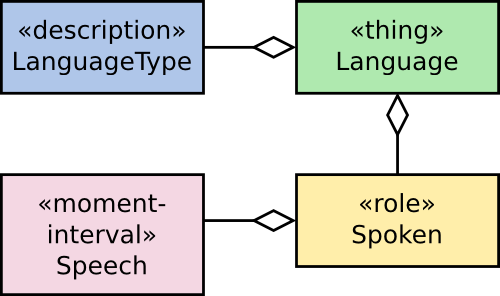Modeling in Color, Part I
Over the past six years, I’ve tried to apply the lessons from Eric Evans’ book with regards to collecting requirements from customers and, then, building a robust object-oriented design that embodies those requirements. I have had quite a bit of success with domain-driven design and can attest to its strengths. However, when I started using Evans’ recommendations, I had already spent the previous eight years honing my OO acumen, decomposing real-world problems into software-based solutions.
As you may have noticed, I haven’t written in a while. Between bringing home the bacon, eating the bacon, and riding around on another porcine entity, I haven’t spent time tending this little word garden. Yeah, shame on me. But, I recently spent some time talking with my nascent development team about object-oriented design and how they should perform it as we move into a business-focused cycle of coding. I wanted some process that would provide a standard by which they could enter into the practice of OOD and come out the other side with philosophically similar designs.
What to do?
Sitting in my office, I looked over at my Bookshelf of Broken Technologies™ and spied a book that I hadn’t read since the early 2000s: Java Modeling In Color With UML: Enterprise Components and Process. I vaguely remembered something about Post-it® Notes. I read the book through and sat back amazed.
This was it! An easy-to-understand, attainable OOD philosophy. With examples.
Let me write that, again. WITH EXAMPLES!
I think that most beginners have trouble with OOD books because they show Dog inherits from Animal. And, that’s it. They want something more. Something
concrete. Coad, et. al. gives 61 concrete examples of how to use modeling in
color.
Head First ain’t got nothing on that.
The basics
I will get the basics out of the way and then explore examples of modeling in color in the following days.
Any domain model consists of four basic class types, or four archetypes. They are:
- Description
- Common information for a kind of thing.
- Thing
- A party, place, or thing.
- Role
- A type of behavior that a _Thing_ takes on to participate in transactions.
- Moment-Interval
- A moment in time or interval of time that has particular importance to the business process or legal purposes.
The «description» provides common attributes and behavior for a «thing». The «thing» takes on a «role» to create or participate in a «moment-interval» transaction.
And, why color? That’s because each of those archetypes have a color associated with them in UML diagrams.
- Description → Blue
- Thing → Green
- Role → Yellow
- Moment-Interval → Pink
And, here’s a dumb example of the relationships.

With the example in the above figure, we see that a LanguageType provides
common descriptive attributes or behavior for Language. (LanguageType
provides prototypal inheritance for Language.) An instance of Language can
have the Spoken role. With that role, the Language can participate in
Speeches.
An academic example, to be sure. Tomorrow, we’ll get into a better example and build an application around it.